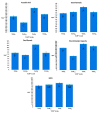Impact of Commercial Seaweed Liquid Extract (TAM®) Biostimulant and Its Bioactive Molecules on Growth and Antioxidant Activities of Hot Pepper (Capsicum annuum)
- PMID: 34064289
- PMCID: PMC8224274
- DOI: 10.3390/plants10061045
Impact of Commercial Seaweed Liquid Extract (TAM®) Biostimulant and Its Bioactive Molecules on Growth and Antioxidant Activities of Hot Pepper (Capsicum annuum)
Abstract
Bioactive molecules derived from seaweed extracts are revolutionary bio-stimulants used to enhance plant growth and increase yield production. This study evaluated the effectiveness of a commercially available seaweed liquid extract, namely, True-Algae-Max (TAM®), as a plant growth stimulant on nutritional, and antioxidant activity of Capsicum annuum. Three concentrations of TAM® (0.25, 0.5, and 1%) of various NPK: TAM® ratios were investigated via foliar spray, over 2017 and 2018 cultivation seasons, under greenhouse conditions. TAM® is rich in phytochemical compounds, such as ascorbic acid (1.66 mg g-1), phenolics (101.67 mg g-1), and flavonoids (2.60 mg g-1) that showed good antioxidant activity (54.52 mg g-1) and DPPH inhibition of 70.33%. Promoting measured parameter results stated the extensive potentiality of TAM® application, in comparison with conventional NPK treatment. Yield and composition of C. annuum were significantly improved in all TAM® treated groups, especially the TAM0.5% concentration, which resulted in maximum yield (4.23 Kg m-2) and significant amounts of profuse biological molecules like chlorophyll, ascorbic, phenolic compounds, flavonoids, and total nutrients. Compared to the NPK control treatments, C. annuum treated with TAM0.5% improved the total antioxidant activity of hot Pepper from 162.16 to 190.95 mg g-1. These findings indicate that the extract of seaweed can be used as an environmentally friendly, multi-functional biostimulant in the agricultural field for more sustainable production, in addition to reducing the use of hazardous synthetic fertilizers.
Keywords: TAM®; antioxidants; clean production; hot pepper; phytochemicals; seaweed biostimulants.
Conflict of interest statement
The authors declare no conflict of interest.
Figures


References
-
- Shambhavi S., Kumar R., Sharma S.P., Verma G., Sharma R.P., Sharma S.K. Long-term effect of inorganic fertilizers and amendments on productivity and root dynamics under maize-wheat intensive cropping in an acid Alfisol. J. Appl. Nat. Sci. 2017;9:2004–2012. doi: 10.31018/jans.v9i4.1480. - DOI
-
- Hassan S., Ashour M., Soliman A. Anticancer Activity, Antioxidant Activity, Mineral Contents, Vegetative and Yield of Eruca sativa Using Foliar Application of Autoclaved Cellular Extract of Spirulina platensis Extract, Comparing to N-P-K Fertilizers. J. Plant Prod. 2017;8:529–536. doi: 10.21608/jpp.2017.40056. - DOI
-
- Ashour M., El-Shafei A.A., Khairy H.M., Abd-Elkader D.Y., Mattar M.A., Alataway A., Hassan S.M. Effect of Pterocladia capillacea Seaweed Extracts on Growth Parameters and Biochemical Constituents of Jew’s Mallow. Agronomy. 2020;10:420. doi: 10.3390/agronomy10030420. - DOI
Grants and funding
- Project titled: Prototype of sustainable marine integrated aquaculture farm for the production of seafood, valuable bio-products, and bio-diesel, SIMAF-Project, Project ID: 1429)./Academy of Scientific Research and Technology
- Researchers Supporting Project number TURSP-2020/53, Taif University, Taif, Saudi Arabia/Taif University
LinkOut - more resources
Full Text Sources
Other Literature Sources

